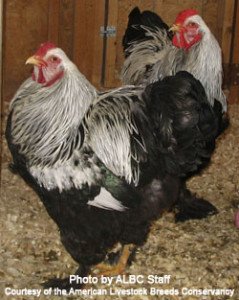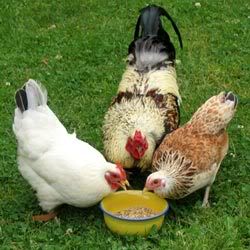Raising Chickens as Pets
When you consider getting a pet, your first thought is a cat or dog. However, keeping chickens as pets is growing in popularity as people become aware of the advantages to having a small, backyard flock.
Chickens are fun and educational: more interesting than TV. Like other pets, chickens have varying personalities. They provide hours of enjoyment as they interact with each other and their surroundings. Did you know you can buy diapers for your chickens so they can come in the house?
Many breeds are easy to manage and tamed by hand-feeding and handling regularly. Some roosters, which many associate with aggressiveness, are tamable with proper handling. I don’t recommend getting a rooster until you’ve had chickens for at least a year and are comfortable with handling them.
Besides the entertainment and educational value, chickens offer several advantages to their upkeep.
Inexpensive—Chickens cost less than you think. Your biggest expense is setting up to house your chickens and that can be done relatively cheaply if you use your imagination. Follow our progress as we build a new coop and pen for $200 or less.
As well as kitchen scraps, chickens need feed. Most feed costs between $10 and $15 for a 50 lb bag. Depending on how many chickens you have, one 50 lb bag may last for one month. I also provide mealy worms as treats in the wintertime. You can get a container for around $5.
Chicks range from $3 to $10 and $10 to over $50 for grown chickens. The price of chickens depends on what you’re raising them for. I have seen grown show roosters go for $50, but for the average backyard chicken farmer, your chicks will cost around $5 each for good laying hens.
I buy online from eFowl. They are located in California and have great service and healthy chicks. I just received a shipment of 15 new chicks: Orpingtons and Ameracaunas. They’re healthy, adorable and so much fun. Shipping is free for orders of 25 or more and only $9.99 for less than 25 chicks.
Eggs—The best known advantage to raising chickens as pets is their eggs. What other pets do you know that feed their owners? Farm fresh eggs from chickens allowed to forage provide healthier eggs with lower cholesterol and higher amounts of Omega-3s.
Allergies—If you can’t own a dog or cat because of fur and dander allergies, consider chickens.
Pest Control—If you try to avoid chemicals and toxins for pest control, then chickens are your best bet. Chickens love bugs and quickly rid your yard of unwanted pests. It’s fun watching them play tag with their latest find; as soon as one drops the bug, the next one has it and the chase is on again.
Natural Garbage Disposal—Don’t throw leftovers and out-of-date food away. Chickens will eat almost anything: vegetables, fruits, melons, greens, and bread to name a few. Never give them meat, eggs or anything moldy. My chickens are especially fond of beet greens (cooked) and melons.
Mow Your Lawn—Do you have a spot you hate to mow? Let your chickens forage in different areas you want weed control; they’ll take it bare dirt for you.
The Black Gold of the Chicken World—Chicken poop is the best fertilizer for gardens. Properly composted poop provides most of the nutrients your soil needs.
We compost in the chicken pen. We place scraps, grass clippings, leaves, etc. in one corner and by the end of the day the pile is flat. We continue adding clippings and food stuff throughout the week then on the weekends, we rake the entire pen move everything outside in our composting pile that is close by then start all over.
Chicken poop needs to set for at least six months before using or you will burn your plants. Start your compost pile as soon as your chickens move outside and you will have a nice fertilizer by the next growing season.
Great Hobby—You can’t go wrong with raising chickens for a hobby. It’s easy and helps teach children pet ownership responsibility. Children and adults find interest in raising show chickens. There are many clubs and organizations offering competitions. It’s a hobby the whole family will enjoy. The breed of show chicken depends on your interest and the age of the person handling the chicken. If your children are going to show them, I suggest small breeds like the Bantam Cochin. If you have fancy in mind, try some of the Japanese breeds.
Always practice proper sanitation and hand washing when handling chicks or any other pets.
My Top Pet Breed Recommendations
Not all chicken breeds make good pets. However, some are friendly and if well cared for may offer you 8 to 12 years of companionship. I advise avoiding roosters until you become an experienced backyard chicken farmer. In some breeds, roosters are aggressive and can hurt you or the other chickens in your flock.
Ameraucana/Easter Egger
 This is the first of my two favorite pet breeds. Thought to have been developed in the United States, much of their popularity comes from laying blue or blue-green colored. Their non aggressive behavior makes them excellent pets for children.
This is the first of my two favorite pet breeds. Thought to have been developed in the United States, much of their popularity comes from laying blue or blue-green colored. Their non aggressive behavior makes them excellent pets for children.
Ameraucanas are sometimes confused with the Araucana. Both have pea combs and red earlobes and lay blue/blue-green colored eggs. The Ameraucana is a different breed and recognizable by their facial muffs and beard, full tails, and slate or black legs.
Ameraucanas come in large and bantam varieties with eight officially recognized colors by the American Poultry Association: White, Black, Blue, Blue Wheaten, Wheaten, Buff, Red Brown, and Silver. Most hatcheries only offer a mixed color selection. The ones that do offer a color choice are slightly more expensive. A full-size hen weighs 5 ½ pounds while a bantam hen only weighs 26 ounces. The large cock weighs in at 6 ½ pounds compared to its bantam counterpart at only 30 ounces.
Named after Orpington, England the Orpington chicken is kept for its excellent laying and meat qualities as well as its docile nature. They lay about 175 to 200 eggs per year and continue laying in the winter when other hens stop laying. Easily tamed, the Orpington makes a great pet.
This attractive chicken with rich coloration and gentle contours is quickly gaining popularity as a show bird. Weighing in at a hefty 7 to 10 pounds, the orpington has soft, fluffy feathers covering its body as well as feathers almost hiding its legs. The original colors are black, white, splash, and the most common, buff. There are other colors but the American Standard only recognizes these.
Cochin
 Large and unique looking, the Cochin is a fluffy chicken with fully feathered legs and feet. It’s friendly and docile, adapting easily to confined spaces or open range.
Large and unique looking, the Cochin is a fluffy chicken with fully feathered legs and feet. It’s friendly and docile, adapting easily to confined spaces or open range.
Standard size Cochin roosters weigh about 11 pounds while the hens weigh 8 ½ pounds. This breed comes in 18 colors with nine birchen, blue, buff, gold laced, silver laced, barred, black, red, lemon, blue, and white.
The Cochin was originally bred in China then exported to the United States and Britain in the 19th century. With its soft and plentiful plumage, this bird is hugely popular for showing as well as keeping for pets.
Brahma
The name Brahma comes from the Brahmaputra river  in India but was created in America. A cross between Shanghais imported from China and India’s Grey Chittagongs, the Brahma is a large chicken with strength and vigor, often called The King of Chicken Breeds. Roosters average a weight of 12 pounds and hens 10 pounds, however some hens have been recorded at 13-14 pounds and roosters a whopping 17 to 18 pounds.
in India but was created in America. A cross between Shanghais imported from China and India’s Grey Chittagongs, the Brahma is a large chicken with strength and vigor, often called The King of Chicken Breeds. Roosters average a weight of 12 pounds and hens 10 pounds, however some hens have been recorded at 13-14 pounds and roosters a whopping 17 to 18 pounds.
Brahmas are a beautiful chicken with deep bodies and full breasts, smooth plumage, dense down and powerful yellow legs covered in feathers. They come in three color varieties: dark, light, and buff.
Brahmas are hardy chickens and superior winter layers. Their eggs are large, medium brown, with the majority laid from October to May. Hens are devoted mothers but care must be taken with new hatchlings as the hen’s large size may trample the chicks.
From 1850 through 1930, Brahma were the leading meat breed. The large bird easily fed a moderate size family. Today, with their docile nature and superior egg laying, Brahmas are the choice for many urban farm pets.
The Brahma is ideal for northern climates, thriving best in moist, cool climates. They are easily contained since they have trouble flying over low fences. With their docile personalities, these chickens adapt to confinement well.


